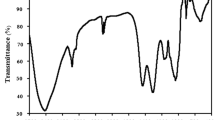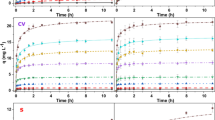Abstract
The present study investigates the sorption of four commercial dyes, namely Methylene Blue (MB), Malachite Green (MG), Indigo Carmine (IC), and Rhodamine B (RB) by dead biomass of Cladophora sp. The test alga exhibited the maximum sorption capacity (qmax) for MG (250.53 mg g−1) followed in decreasing order by MB (94.76), IC (63.20), and RB (16.50). The sorption of MB and MG was influenced by the initial pH of the solution. It increased consistently as pH increased from 2 to 8. Whereas sorption of the other two dyes, RB and IC, is almost pH-independent and decreased slightly as pH increased from 2 to 4. The sorption of all the test dyes by Cladophora biomass was rapid and the process attained equilibrium within 4–8 h. The general-order rate law appropriately fitted to the time course sorption data of all the test dyes (adj R2 > 0.989). The kinetic order of the sorption reaction varied from 1.62 to 3.77 for different dyes. Freundlich, Langmuir, Redlich-Peterson and Sips models suitably described the equilibrium sorption data of the test dyes. However, the last three models showed a marginal superiority over the Freundlich model by revealing a slightly higher adj R2 value for each studied dye. Nonetheless, the test biomass could be a suitable biosorbent as it rapidly sorbed the substantial amounts of both cationic and anionic dyes from the aqueous solutions and is also easily and widely available as a low-cost algal material.






Similar content being viewed by others
References
Anisuzzaman SM, Joseph CG, Daud WMABW, Krishnaiah D, Yee HS (2015) Preparation and characterization of activated carbon from Typha orientalis leaves. Int J Ind Chem 6:9–21
Arenas CN, Vasco A, Betancur M, Martınez JD (2017) Removal of indigo carmine (IC) from aqueous solution by adsorption through abrasive spherical materials made of rice husk ash (RHA). Proc Safety Environ Protect 106:224–238
Aroguz AZ, Gulen J, Evers RH (2008) Adsorption of methylene blue from aqueous solution on pyrolyzed petrified sediment. Bioresour Technol 99:1503–1508
Balistrieri LS, Murray JW (1981) The surface chemistry of goethite (alpha Fe-OOH) in major ion seawater. Am J Sci 281:788–806
Banat F, Al-Asheh S, Al-Ahmad R, Bni-Khalid F (2007) Bench-scale and packed bed sorption of methylene blue using treated olive pomace and charcoal. Bioresour Technol 98:3017–3025
Borah D, Kennedy B, Gopalakrishnan S, Chithonirai A, Nooruddin T (2020) Bioremediation and biomass production with the green microalga Chlorococcum humicola and textile mill effluent (TE). Proc Natl Acad Sci India Sect B Biol Sci 90:415–423
Chandra TS, Mudliar SN, Vidyashankar S, Mukherji S, Sarada R, Krishnamurthi K, Chauhan VS (2015) Defatted algal biomass as a non-conventional low-cost adsorbent: surface characterization and methylene blue adsorption characteristics. Bioresour Technol 184:395–404
Couto SR (2009) (2009) Dye removal by immobilised fungi. Biotechnol Adv 27:227–235
Dada AO, Adekola FA, Odebunmi EO, Dada FE, Bello OM, Akinyemi BA, Bello OS, Umukoro OG (2020) Sustainable and low-cost Ocimum gratissimum for biosorption of indigo carmine dye: kinetics, isotherm, and thermodynamic studies. Int J Phytoremed 22:1524–1537
Ekpete OA, Marcus AC, Osi V (2017) Preparation and characterization of activated carbon obtained from plantain (Musa paradisiaca) fruit stem. J Chem 2017:1–6
Eren E, Afsin B (2008) Investigation of a basic dye adsorption from aqueous solution onto raw and pre-treated bentonite surfaces. Dyes Pigments 76:220–225
Gadd GM (2009) Biosorption: critical review of scientific rationale, environmental importance and significance for pollution treatment. J Chem Technol Biotechnol 84:13–28
Goertzen SL, Thériault KD, Oickle AM, Tarasuk AC, Andreas HA (2010) Standardization of the Boehm titration. Part I. CO2 expulsion and endpoint determination. Carbon 48:1252–1261
Gupta VK, Suhas (2009) Application of low-cost adsorbents for dye removal: a review. J Environ Manage 90:2313–2342
Gupta S, Kumar D, Gaur JP (2009) Kinetic and isotherm modeling of lead(II) sorption onto some waste plant materials. Chem Eng J 148:226–233
Hamouda RA, El-Naggar NE, Doleib NM, Saddiq AA (2020) Bioprocessing strategies for cost-effective simultaneous removal of chromium and malachite green by marine alga Enteromorpha intestinalis. Sci Rep 10:13479
Han S, Han W, Chen J (2020) Bioremediation of malachite green by cyanobacterium Synechococcus elongatus PCC 7942 engineered with a triphenylmethane reductase gene. Appl Microbiol Biotechnol 104:3193–3204
Jegan J, Vijayaraghavan J, Bhagavathi Pushpa T, Sardhar Basha SJ (2016) Application of seaweeds for the removal of cationic dye from aqueous solution. Desalination Water Treat 57:25812–25821
Kumar D, Gaur JP (2011a) Chemical reaction- and particle diffusion-based kinetic modeling of metal biosorption by a Phormidium sp.-dominated cyanobacterial mat. Bioresour Technol 102:633–640
Kumar D, Gaur JP (2011b) Metal sorption by two cyanobacterial mats in relation to pH, biomass concentration, pretreatment, and reuse. Bioresour Technol 102:2529–2535
Kumar D, Pandey LK, Gaur JP (2016) Metal sorption by algal biomass: from batch to continuous system. Algal Res 18:95–109
Kumar D, Singh A, Pandey LK, Gaur JP (2012) Sorption of methylene blue by an Oscillatoria sp.-dominated cyanobacterial mat. Bioremed J 16:48–56
Kumar M, Kumar D, Pandey LK, Gaur JP (2010) Methylene blue sorption capacity of some common waste plant materials. Chem Eng Comm 197:1435–1444
Lebron YAR, Moreira VR, San LVS (2019) Studies on dye biosorption enhancement by chemically modified Fucus vesiculosus, Spirulina maxima and Chlorella pyrenoidosa algae. J Clean Prod 240:118197
Lellis B, Fávaro-Polonio CZ, Pamphile JA, Polonio JC (2019) Effects of textile dyes on health and the environment and bioremediation potential of living organisms. Biotechnol Res Innov 3:275–290
Liu Y, Liu YJ (2008) Biosorption isotherms, kinetics and thermodynamics. Sep Purif Technol 61:229–242
Mahajan P, Kaushal J (2020) Phytoremediation of azo dye methyl red by macroalgae Chara vulgaris L.: kinetic and equilibrium studies. Environ Sci Pollut Res 27:26406–26418
Majhi PK, Kothari R, Pandey A (2020) Adsorptive behavior of free and immobilized Chlorella pyrenoidosa for decolorization. Biomass Conv Bioref. https://doi.org/10.1007/s13399-020-00770-6
Mehta SK, Gaur JP (2005) Use of algae for removing heavy metal ions from wastewater: progress and prospects. Crit Rev Biotechnol 25:113–152
Mittal A, Mittal J, Kurup L (2006) Batch and bulk removal of hazardous dye, indigo carmine from wastewater through adsorption. J Hazard Mater b 137:591–602
Mohan SV, Ramanaiah SV, Rajkumar B, Sarma PN (2007) Removal of fluoride from aqueous phase by biosorption onto algal biosorbent Spirogyra sp.-IO2: sorption mechanism elucidation. J Hazard Mater 141:465–474
Pavan FA, Lima EC, Dias SLP, Mazzacato AC (2008) Methylene blue bisorption from aqueous solution by yellow passion fruit waste. J Hazard Mater 150:703–712
Pereira L, Alves M (2012) Dyes-environmental impact and remediation. Environmental protection strategies for sustainable development. Springer, Dordrecht, pp 111–162
Pushpa TB, Vijayaraghavan J, Vijayaraghavan K, Jegan J (2016) Utilization of effective microorganisms based water hyacinth compost as biosorbent for the removal of basic dyes. Desalin Water Treat 57:24368–24377
Rai J, Kumar D, Gaur JP (2019) Sorption of malachite green (a cationic dye) and heavy metals by dead biomass of Phormidesmis molle (cyanobacteria)-dominated mat. Water Environ J 33:51–60
Rangabhashiyam S, Balasubramanian P (2018a) Utilization of unconventional lignocellulosic waste biomass for the biosorption of toxic triphenylmethane dye malachite green from aqueous solution. Int J Phytoremediat 20:624–633
Rangabhashiyam S, Balasubramanian P (2018b) Biosorption of hexavalent chromium and malachite green from aqueous effluents, using Cladophora sp. Chem Ecol 34:371–390
Ravindran G, Ganapathy GP, Josephraj J, Alagumalai A (2019) A critical insight into biomass derived biosorbent for bioremediation of dyes. ChemistrySelect 4:9762–9775
Romera E, Gonzalez F, Ballester A, Blazquez ML, Munoz JA (2006) Biosorption with algae: a statistical review. Crit Rev Biotechnol 26:223–235
Saufi H, El-Alouani M, Aride J, Taibi M (2020) Rhodamine B biosorption from aqueous solution using Eichhornia crassipes powders: Isotherm, kinetic and thermodynamic studies. Chem Data Collect 25:100330–100331
Sears GW (1956) Determination of specific surface area of colloidal silica by titration with sodium hydroxide. Anal Chem 28:1981–1983
Shabbir S, Faheem M, Ali N, Kerr PG, Wu Y (2017) Periphyton biofilms: a novel and natural biological system for the effective removal of sulphonated azo dye methyl orange by synergistic mechanism. Chemosphere 167:236–246
Singh A, Kumar D, Gaur JP (2008) Removal of Cu (II) and Pb (II) by Pithophora oedogonia: sorption, desorption and repeated use of the biomass. J Hazard Mater 152:1011–1019
Singh KA, Kumar PA, Srivastava RA (2017) An overview of textile dyes and their removal techniques: Indian perspective. Pollut Res 36:790–797
Singh S, Kumar A, Gupta H (2020) Activated banana peel carbon: a potential adsorbent for Rhodamine B decontamination from aqueous system. Appl Water Sci 10:185
Sun D, Yang X (2017) Rapid determination of toxic Rhodamine B in food samples using exfoliated graphene-modified electrode. Food Anal Methods 10:2046–2052
Sutherland DL, Ralph PJ (2019) Microalgal bioremediation of emerging contaminants- opportunities and challenges. Water Res 164:114921
Tang Y, He T, Liu Y, Zhou B, Yang R, Zhu L (2018) Sorption behaviour of methylene blue and rhodamine B mixed dyes onto chitosan graft poly (acrylic acid-co-2-acrylamide-2-methyl propane sulfonic acid) hydrogel. Adv Polym Technol 37:2568–2578
Tkaczyk A, Mitrowska K, Posyniak A (2020) Synthetic organic dyes as contaminants of the aquatic environment and their implications for ecosystems: a review. Sci Total Environ 717:137222
Tsai WT, Chen HR, Kuo KC (2011) Surface characterization of dead microalgae-based biomass using methylene blue adsorption. Surf Interface Anal 43:959–963
Vijayaraghavan K, Mao J, Yun YS (2008) Biosorption of methylene blue from aqueous solution using free and polysulfone-immobilized Corynebacterium glutamicum: Batch and column studies. Bioresour Technol 99:2864–2871
Vijayaraghavan K, Premkumar Y, Jegan J (2016) Malachite green and crystal violet biosorption onto coco-peat: characterization and removal studies. Desalin Water Treat 57:6423–6431
Visa M, Chelaru AM (2014) Hydrothermally modified fly ash for heavy metals and dyes removal in advanced wastewater treatment. Appl Surf Sci 303:14–22
Yaseen DA, Scholz M (2019) Textile dye wastewater characteristics and constituents of synthetic effluents: a critical review. Int J Environ Sci Technol 16:1193–1226
Acknowledgements
BMS thanks the Head, Department of Botany, T. D. Postgraduate College, Jaunpur, Uttar Pradesh for the necessary facilities. VU and DK acknowledge the Head, Department of Botany and Microbiology, School of Life Sciences, H. N. B. Garhwal University, Srinagar, Garhwal, for encouragement and support.
Author information
Authors and Affiliations
Contributions
BMS planned and executed experiments, prepared a draft of the manuscript and finalized the manuscript for submission. VU performed the physicochemical characterization of the biomass. DK helped in processing and interpreting data and finalization of the manuscript. AS was involved in conceiving the idea, planning the experiments, presentation and discussion of results.
Corresponding author
Ethics declarations
Conflict of interest
The authors declare that they have no conflict of interest.
Additional information
Editorial responsibility: Samareh Mirkia.
Rights and permissions
About this article
Cite this article
Seth, B.M., Uniyal, V., Kumar, D. et al. Sorption of cationic and anionic dyes by dead biomass of filamentous green alga Cladophora sp. (Chlorophyceae). Int. J. Environ. Sci. Technol. 19, 12079–12090 (2022). https://doi.org/10.1007/s13762-021-03802-4
Received:
Revised:
Accepted:
Published:
Issue Date:
DOI: https://doi.org/10.1007/s13762-021-03802-4




